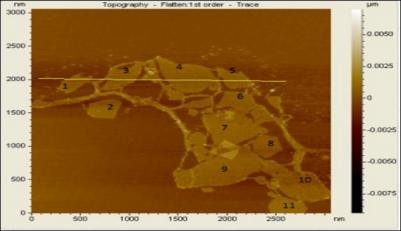 Angstron Materials (owned by Nanotek Instruments and based in Ohio, USA) is a graphene nanoplatelets (GNPs) and single-layer graphene sheets developer and producer.
Angstron Materials (owned by Nanotek Instruments and based in Ohio, USA) is a graphene nanoplatelets (GNPs) and single-layer graphene sheets developer and producer.
Ian Fuller, the company's marketing and business development chief, was kind enough to answer a few questions we had regarding the company's technology and business. Ian joined Nanotek Instruments in 2006, focusing on fuel cells. He later joined the Angstron Materials team.
Q: Hello Ian, and thanks for agreeing to this interview. Can you give us a short company overview?
Nanotek Instruments was founded in 1997 and performs R&D on novel applications of nanomaterials. It focuses largely on novel energy storage and generation applications including lithium batteries, fuel cells, and supercapacitors.
Angstron Materials was spun-off from Nanotek Instruments in 2007 for the expressed purpose of manufacturing commercial volumes of ultra-thin, pristine nano-graphene platelets (NGPs) at a price point capable of supporting wide scale market adoption. Production is currently ramping up significantly to keep pace with increasing customer demand.
Q: Can you detail the current products you are offering and what are the current applications? Can you give any details regarding your clients?
Currently, Angstron offers six standard products along with a range of custom graphene materials. These nano-graphene platelets are, in essence, arrangements of individual atomic layers manufactured from macroscopic natural graphite, (a top-down approach). Our standard products include Angstron’s N002-PS, an aqueous few-layer (?3) layer graphene oxide solution, and N002-PDR, a pristine, less than 1 nanometer thick graphene powder. The products, supplied by Angstron Materials have been used successfully in applications ranging from Li-ion batteries, supercapacitors, lubricants, and thermal management materials to polymer and ceramic composites, transparent conductive films, and biomedical applications.

The customer base right now is as diverse as the potential applications with sales made to military, large multi-nationals, small R&D companies, as well as universities and research institutions. In the past year we have provided customers in over 25 countries with our graphene products. Angstron’s graphene materials are currently being used in commercial applications in Asia but we cannot disclose any details due to confidentiality agreements with our customers.
Q: Do you produce the NGPs in-house? can you tell us a bit more about the manufacturing process and equipment? What is your annual capacity?
Angstron produces all of our raw materials in-house at one of our two manufacturing centers. While I can’t go into the details of our production process, I can say that all of our materials are produced using the top-down approach in which a base graphite source is cleaved into thinner and thinner sheets.
We are currently continuing to scale up our production in order to keep pace with the demand for the materials. Our annual production volume is 300 metric tons and we plan to expand our capacity to 1300 metric tons by Q4 of 2015.
Q: I know that other companies (such as XG Sciences and Haydale, for example) also offer these kind of materials. Can you tell us what differentiate your materials?
There are two distinct differences between our products and our competitors’ products. The first is our ability to produce pristine graphene that is less than 1 nm thick from our top-down approach. This product, our N002-PDR, is unique in the industry and provides our customers with a unique set of properties and potential applications. The fact that it this material is produced without the need for high temperatures or vacuum (as typically needed for CVD-type graphene) results in a large, low cost production capability.
This production capacity is a distinguishing feature for Angstron. Less than six months ago we dramatically reduced the price of our N002-PDR product. This was a direct result of further production capacity coming online. As we continue our scale-up process we anticipate further price reductions and larger available quantities. This will provide our customers with a very strong value proposition by allowing them to incorporate unique graphene capabilities while maintaining a price-sensitive overview.
Q: A few months ago you announced plans to raise $8-10 million. How is the fund raising progressing?
Our plans to raise $10 million are still on track. We anticipate making an announcement in Q2 2014.
Q: In 2010 the DOE awarded Angstron and K2 ES with a project to develop hybrid NGP based anodes for Li-ion batteries. Is this project still going on?
The DOE phase I and II grants were actually awarded to Nanotek Instruments, Angstron Material’s affiliated company. Nanotek uses Angstron’s graphene products to create the silicon anode material for lithium ion batteries. The production of this proprietary product is currently being scaled-up in order to meet demand from battery manufacturers. One of the key points is that, by incorporating graphene into the Si anode material, Nanotek is able to essentially negate the issues that have plagued traditional Si anodes.
In short, Nanotek has a Si anode product that allows for the production of very energy dense batteries with hundreds of useable cycles. This is a graphene enhanced product that is quickly making its way to market
Q: When do you think that Graphene based products will hit the market? What will be the first products?
Angstron is already supplying graphene materials for commercial applications. However, I really think the thermal and barrier properties are some of the most under-reported and interesting properties of graphene materials. I also believe that these may be some of the first graphene applications that reach a consumer level. The high thermal conductivity of graphene, combined with its wide range of form factors and relatively low price point will, in my opinion, provide a significant market pull in multiple areas where heat management is necessary.
Furthermore, the ability of graphene to act as a barrier to practically everything is a very attractive property. This may be used for metallic corrosion protection or for packaging materials. This probably won’t be the first application but imagine the market pull if soft drink makers didn’t have to worry about their products going flat. Or food packaging that dramatically reduces the rate of food spoilage by eliminating the permeation of oxygen and water. I think these are a couple of very interesting, under-the-radar, applications that could hit the market sooner than anticipated.
Q: Where do you see the graphene industry/market in 5 years? What role will Angstron Materials have?
In five years Angstron’s production facilities will be operating at full capacity producing a range of graphene products. Graphene materials themselves will have almost reached a commodity type pricing structure and early applications will be reaching the consumer. We anticipate maintaining our position as the world’s leading producer of graphene materials and will be offering several value added type products as well. These will be graphene products tailored for a specific industry or application. This effort will help accelerate large scale applications by creating a plug-and-play type graphene product that will require little to no R&D on the part of the OEM.
Thanks Ian! I wish both you and Angstron Materials the best of luck...